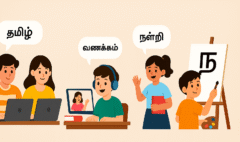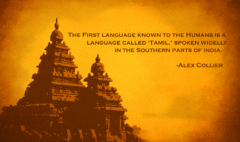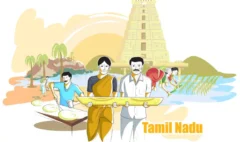The Role of Tamil in Tamil Nadu’s Political Landscape
The Role of Tamil in Tamil Nadu’s Political Landscape
The Role of Tamil in Tamil Nadu’s Political Landscape: A Language of Identity and Power
In the vibrant, complex, and often theatrical world of Tamil Nadu’s political landscape, the Tamil language holds a position of unparalleled importance. It is not merely a medium for communication; it is the very lifeblood of the region’s political identity. It is a powerful symbol of an ancient heritage, a finely honed instrument for populist rhetoric, and the primary vehicle for political mobilization. To truly understand the dynamics of politics in Tamil Nadu, one must first appreciate the profound and deeply emotional connection that the people and their leaders have with their language. An understanding of the key Tamil political vocabulary is essential for anyone interested in learning Tamil for politics and for following the state’s dynamic public affairs.
The state’s modern political history was forged in the crucible of language-based movements, and this legacy continues to shape the discourse to this day. The speeches of the great political leaders in Tamil Nadu are legendary, and their masterful use of the language has been a key to their enduring power. This guide will explore the central and multifaceted role that the Tamil language plays in the politics of the state, providing a crucial insight into the language of power in this unique region.
The Historical Foundation: The Dravidian Movement and the Primacy of Language
The story of modern Tamil politics is inextricably linked with the rise of the Dravidian Movement in the mid-20th century. This movement was, at its core, a socio-political movement that championed the cause of Dravidian identity, social justice, and, most importantly, the protection and glorification of the Tamil language.
- The Anti-Hindi Agitations: The pivotal moments that solidified the movement’s power were the anti-Hindi agitations. The proposal to make Hindi the sole official language of India was seen as a direct threat to the ancient and classical Tamil language. This perceived linguistic imposition sparked massive protests and a powerful political awakening across the state.
– The Rise of Orator-Leaders: The leaders of the Dravidian Movement, such as C. N. Annadurai (known affectionately as “Anna,” or elder brother) and M. Karunanidhi (“Kalaignar,” or artist), were not just politicians; they were brilliant writers, playwrights, and orators. They harnessed the power of a highly stylized, alliterative, and emotionally charged form of Tamil to connect with the masses. Their speeches, filled with references to classical Tamil literature and the glory of the Tamil past, were a form of political theater that captivated the public imagination.
This history cemented the idea that a politician’s command of the Tamil language was a direct measure of their authenticity and their commitment to the people.
The Language of Modern Political Discourse
This legacy continues to be a dominant force in the contemporary political landscape.
- The Power of the Public Speech: Even today, the public speech is the centerpiece of political campaigning in Tamil Nadu. A political leader is expected to be a powerful orator. Rallies are often judged by the quality of the leader’s speech—its lyrical quality, its emotional appeal, and its clever use of wordplay and literary allusions.
– A Symbol of Identity: The Tamil language is frequently used as a powerful symbol of the state’s unique identity and its autonomy within the Indian federal system. The protection of Tamil rights and the promotion of the language are perennial and potent political issues.
– Cinema and Politics: There is a unique and powerful connection between the Tamil film industry (Kollywood) and Tamil politics. Many of the state’s most powerful political leaders, including M. G. Ramachandran (MGR), M. Karunanidhi, and J. Jayalalithaa, had their origins as film scriptwriters or actors. They honed their ability to connect with the public and to deliver powerful dialogue on the silver screen, a skill they then transferred to the political stage with immense success.
An Essential Glossary of Tamil Political Vocabulary
For anyone who is learning Tamil for politics or who simply wants to follow the news with a deeper understanding, this core vocabulary is essential.
The System and the Players:
- Politics – அரசியல் (Arasiyal)
- Government – அரசாங்கம் (Arasaangam)
– State Government – மாநில அரசு (Māṉila aracu)
– Central Government – மத்திய அரசு (Mattiya aracu)
– Leader – தலைவர் (Thalaivar)
– Chief Minister – முதலமைச்சர் (Muthalamaichar)
– Minister – அமைச்சர் (Amaiccar)
– Political Party – அரசியல் கட்சி (Arasiyal kaṭci)
– The People – மக்கள் (Makkaḷ)
– The Public – பொதுமக்கள் (Potumakkaḷ)
Key Political Concepts:
- Election – தேர்தல் (Tērthal)
– Vote – வாக்கு (Vākku)
– Majority – பெரும்பான்மை (Perumpāṉmai)
– Opposition Party – எதிர்க்கட்சி (Etirkkaṭci)
– Alliance – கூட்டணி (Kūṭṭaṇi)
– Policy / Ideology – கொள்கை (Koḷkai)
– Development – வளர்ச்சி (Vaḷarcci)
– Social Justice – சமூக நீதி (Camūka nīti)
– Rights – உரிமை (Urimai)
– Law – சட்டம் (Caṭṭam)
– Protest / Agitation – போராட்டம் (Pōrāṭṭam)
– Speech / Oration – உரை (Urai) / சொற்பொழிவு (Coṟpoḻivu)
– Promise / Manifesto – வாக்குறுதி (Vākkuṟuti)
The Major Political Parties
The names of the two major Dravidian parties are themselves important pieces of Tamil political vocabulary.
- DMK (Dravida Munnetra Kazhagam) – திராவிட முன்னேற்றக் கழகம் – “Dravidian Progress Federation”
- AIADMK (All India Anna Dravida Munnetra Kazhagam) – அனைத்திந்திய அண்ணா திராவிட முன்னேற்றக் கழகம் – “All India Anna Dravidian Progress Federation” (named in honor of C.N. Annadurai)
Conclusion: A Language That Moves a Nation
In the dynamic and passionate political theater of Tamil Nadu, the Tamil language takes center stage. It is the language of identity, of protest, of power, and of the profound connection between the political leaders in Tamil Nadu and the people they serve. To understand the political landscape of the state, one must listen not just to what is being said, but to how it is being said—the poetic flourishes, the classical allusions, and the emotional resonance of the language itself. For the student of politics and the student of Tamil, the speeches and the writings of the region’s political figures offer a deep and fascinating insight into a culture where language and power are, and have always been, inextricably intertwined.









